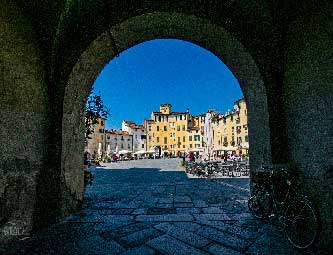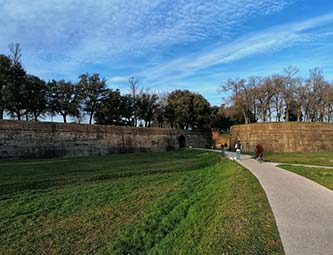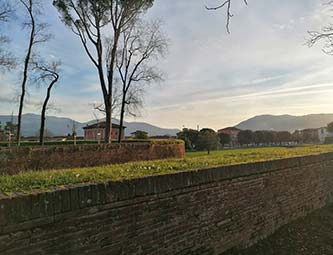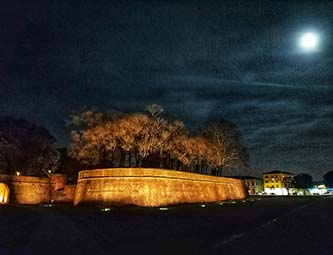Lucca
Hotel Napoleon Lucca

Lucca is one of the most important Italian cities of art, famous for his intact and sixteenth-century walls long 5 kilometres around historical centre (viable only on food or by bike) proposed as heritage of humanity UNESCO.
Lucca is also called “city of 100 churches” thanks to several churches, towers (Guinigi, delle Ore.. ), bell towers, buildings (Guinigi, Pfanner..) and urban spaces as Piazza Dell’Anfiteatro built on the ruins of the Roman amphitheatre.
The medieval long street called Via Fillungo brings together the commercial establishments and the squares like Piazza San Michele with her church, San Martino where the famous Duomo stands and finally Piazza del Giglio with his theatre.
Lucca is the hometown of numerous composers, artists, architects and poets.
«Tu vedi lunge gli uliveti grigi che vaporano il viso ai poggi, o Serchio, e la città dall'arborato cerchio, ove dorme la donna del Guinigi [...]» (Gabriele D'Annunzio, Elettra)
Is also famous for the cultivation of cereal, vines and olives, basic ingredient of typical Tuscan food, like tordelli (pasta), buccellato (sweet bread), castagnaccio and pasimata, everything wet in a good Montecarlo Doc or other wine from Lucca’s hills.
There are other places of interest:
Polo Tecnico Lucchese, which rises in the area of Oleificio Bertolli, is the seat of trade fairs (MIAC..), exhibitions (Expo feline, Collezionando..) and congress.
The most important sports facility is the Porta Elisa’s stadium that accommodate the football match of Associazione spostiva Lucchese Libertas or the Campo SCuola “Moreno Martini” where the match of basket or athletics take place.
The most important events of the Lucca territory are:
- Festa della Esaltazione della Santa Croce: during the evening of 13 September inside of the walls of Lucca there is a long religious procession that reaches the Duomo to venerate the imagine of Sainf of Lucca, wooden crucifix with the form of Christ. Surrounded by little lights spread over all the town. There are also some parade with band and crossbowmen and Associazione Lucchesi in the world.
- Festa di San Paolino, Patrono di Lucca: the 12 July thake place the traditional Palio of Balestra with famous terzieri and tiratori
- Every year during the month of April and September on the walls take place “Mostre mercato del giardinaggio amatoriale” as Verdemuraand Murabilia-Mura in fiere.
- During the month of July in the Piazza Napoleone or on the stands take place Lucca Summer Festival, with world-renowned artists, this event attracts people from all over the world.
- During the whole year in the Basilica of San Giovanni there is “Puccini e la sua Lucca” with professional interpreters offer different programs every nights.
- Between the last days of October and the first day of November take place the second important convention in the world about comics, games and videogames called Lucca Comics & Games.
How to get to Lucca:
Lucca is connected to the highway A11Firenze-Mare con two motorway exit (East and West), there is also the connection to reach Viareggio, little city on the sea. Other important way is Strada Statale 12 del Brennero that start in Pisa and finish in Austria.
Lucca train station offers a valid connection to Florence, Pisa, Viareggio and other important places, is also provided by parking fees inside and outside of the walls.
Ben fornita di parcheggi a pagamento, sia dentro le Mura che fuori, dispone anche di
All these important aspect make Lucca an important strategic point to visit: :
- Other city of arts like Pisa, Florence and Siena
- Cinque terre and Cave di Marmo of Carrara
- Versilia’s coastline, Lido di Camaiore, Pietrasanta and Forte dei Marmi
- The mountain of Garfagnana with his Grotta del vento
- The Montecarlo’s Hills famous for the wine and olives production
- Il Capannorese and his Ville
- The Via Francigena
- The thermes in Bagni di Lucca and San Giuliano
- The fairytale word of Pinocchio and Collodi













